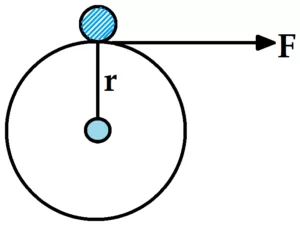In this article we will discuss armature torque and shaft torque. But before we discuss these two torques, let us first understand how is torque generate in a DC motor?
The DC machine is loaded in the form of a motor or generator, so the rotor conductors carry the current, and these conductors are located in the magnetic field of the air gap. So in this way each conductor experiences a force and the conductors are located near the surface of the rotor at a common radius from its center. Hence, a torque is produce around the periphery of the rotor, and the rotor starts rotating.
So now we will understand armature torque and shaft torque :
What is the armature torque of a DC motor?
By the term torque is meant the turning or twisting moment of a force about an axis. And it is measure by the product of the force (F) and the radius (r), the angle at which the force acts, i.e., T = F×r
In a DC motor, each conductor is acted upon by a circumferential force F over a distance r, the radius of the armature. Therefore, each conductor exerts a torque to rotate the armature. The sum of the torques due to all the armature conductors is known as the gross or armature torque (Ta)

Let in a DC motor,
r = Average radius of armature in m
l = Effective length of each conductor in m
z = Total number of armature conductors
A = Number of parallel paths
i = Current in each conductor
B = Average flux density in Wb/m2
Φ = Flux per pole in Wb
P = Number of poles
Force on each conductor, F = Bil newtons
Torque due to one conductor = F × r newton – meter
Total armature torque, Ta = Z F r newton – meter = Z Bil r
Now, i = Ia /A, B = Φ/a
Where ‘a’ is the x-sectional area of the flux path per pole at radius r. Clearly, a = 2πrl / P.
Therefore, Ta = Z × (Φ/a) × (Ia / A) × l × r
Ta = 0.159 ZΦ Ia (P/A) N-M …..eq (1)
Since Z, P and A are fixed for a given machine,
Therefore, Ta ∝ Φ Ia
Hence torque in a DC motor is directly proportional to flux per pole and armature current.
Alternative expression for Ta :
Eb = PΦZN/60 A
Therefore, PΦZ/A = (60 × Eb ) / N
From eq (1), we get the expression of Ta as :
1. For a shunt motor, flux Φ is practically constant.
Therefore, Ta ∝ Ia (For shunt motor only)
2. For a series motor, the flux Φ is directly proportional to the armature current Ia provided there is no magnetic saturation.
Therefore, Ta ∝ I2a
Case-1 : If the motor is an saturate condition then Φ is constant and Ta ∝ Ia
Case-2 : If the motor is an unsaturated condition then Φ is directly proportional to Φ ∝ Ia and Ta ∝ I2a
What is shaft torque in DC motor?
The torque which is available on the motor shaft to do useful work is known as shaft torque. It is represent by the Tsh. The diagram below shows the concept of shaft torque.

The total torque Ta developed in the armature of a motor is not available at the shaft as a part of it is lost in overcoming iron and frictional losses in the motor. Therefore, the shaft torque Tsh is slightly less than the total armature torque Ta. The difference Ta − Tsh is known as the lost torque.
Lost torque =
Output power in watts :
P =
Tsh =
Tsh =
See also this article :
1. What is DC motor? – Principle, Working, Types, Back emf, Significance
2. What is the DC generator? : Construction, Working principle, Types, EMF equation, Losses
3. What are the applications of DC generator?
4. What are the characteristics of DC generator?
5. What is a 3 phase induction motor?
So, I hope this information will help you.
